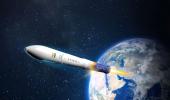Twice every 12 days, the NISAR satellite will scan nearly all of earth's land and ice surfaces to measure changes in the planet's ecosystems, growth and retreat of its land and sea ice, and deformation of its crust.

ISRO is gearing up for the June launch of the NISAR (NASA-ISRO Synthetic Aperture Radar) satellite, a joint initiative of India and the US.
The Geosynchronous Satellite Launch Vehicle (GSLV) -- code-named GSLV-F16 -- will orbit NISAR sometime this June.
ISRO began the launch campaign activities at Sriharikota in the first week of April.
After the completion of work related to NISAR at ISRO's Satellite Integration and Testing Establishment located in Bengaluru, the US National Aeronautics and Space Administration (NASA) had said the two countries are reviewing the launch date.
Changing Goal Posts
The NISAR launch has been changed a couple of times owing to various reasons. ISRO had earlier said the NISAR satellite would be launched in 2022 or early 2023.
ISRO and NASA signed an equal partnership on September 30, 2014 to collaborate on and launch NISAR.
SAR - Not For Surveillance
NISAR is a first-of-a-kind dual-band radar satellite that will measure land deformation from earthquakes, landslides, and volcanoes, producing data for science and disaster response.
It will track how much glaciers and ice sheets are advancing or retreating and it will monitor growth and loss of forests and wetlands for insights on the global carbon cycle.
Twice every 12 days, the NISAR satellite will scan nearly all of earth's land and ice surfaces to measure changes in the planet's ecosystems, growth and retreat of its land and sea ice, and deformation of its crust.
The data gathered will assist in tasks as infrastructure monitoring, disaster response, biomass assessment, and agricultural management.
ISRO identified science and applications that were complementary to the primary mission objectives: Agricultural monitoring and characteriSation, landslide studies, Himalayan glacier studies, soil moisture, coastal processes, coastal winds, and monitoring hazards.
Though NISAR has the SAR (synthetic aperture radar), a former ISRO chairman had earlier said NISAR will not be used for surveillance and will be used for earth observation.
Under this collaborative project, NASA is responsible for providing the L-Band SAR payload system and the Indian agency will supply S-Band SAR payload.
Both the SAR systems will make use of a large size (about 12m diameter) common unfurlable reflector antenna.
That apart, NASA also provides engineering payloads, including a payload data subsystem, a high-rate science downlink system, GPS receivers and a solid state recorder.
The spacecraft bus, the S-band radar, launch vehicle and associated launch services are provided by ISRO.
NISAR will be the first earth-observing satellite with two kinds of radar -- an L-band system with a 10-inch (25-centimeter) wavelength and an S-band system with a 4-inch (10-centimeter) wavelength.
Whether microwaves reflect or penetrate an object depends on their wavelength.
Shorter wavelengths are more sensitive to smaller objects such as leaves and rough surfaces, whereas longer wavelengths are more reactive with larger structures like boulders and tree trunks.
So NISAR's two radar signals will react differently to some features on earth's surface.
By taking advantage of what each signal is or isn't sensitive to, researchers can study a broader range of features than they could with either radar on its own, observing the same features with different wavelengths.
The NISAR observatory carries a 12m wide deployable mesh reflector mounted onto a deployable 9m boom developed by NASA's Jet Propulsion Laboratory which shall be used by both-JPL-NASA developed L-Band SAR payload system and ISRO developed S-Band SAR payload.
After the successful in-orbit checkout of the satellite, the science operations phase will start and extend for three years and contain all data collection required to achieve the L1 science objectives.
During this phase, the science orbit will be maintained via regular maneuvers, scheduled to avoid or minimise conflicts with science observations.
Extensive calibration and validation activities will take place throughout the first five months, with yearly updates of 1-month duration.
Venkatachari Jagannathan can be contacted at venkatacharijagannathan@gmail.com
Feature Presentation: Aslam Hunani/Rediff










